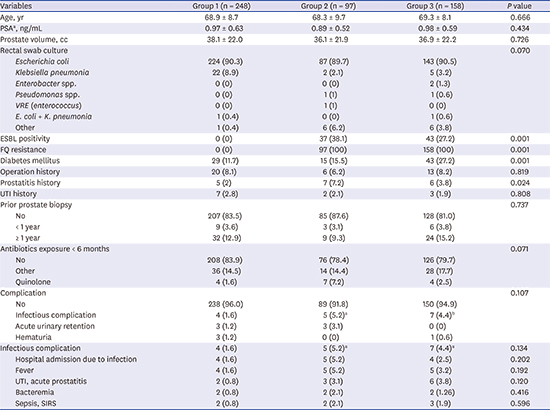1. Tufan ZK, Bulut C, Yazan T, Hatipoglu C, Erdinc S, Kinikli S, et al. A life-threatening Escherichia coli meningitis after prostate biopsy. Urol J. 2011; 8(1):69–71.
2. Bootsma AM, Laguna Pes MP, Geerlings SE, Goossens A. Antibiotic prophylaxis in urologic procedures: a systematic review. Eur Urol. 2008; 54(6):1270–1286.

3. Sieber PR, Rommel FM, Agusta VE, Breslin JA, Huffnagle HW, Harpster LE. Antibiotic prophylaxis in ultrasound guided transrectal prostate biopsy. J Urol. 1997; 157(6):2199–2200.

4. Patel U, Kirby R. Infections after prostate biopsy and antibiotic resistance. BJU Int. 2008; 101(10):1201–1202.

5. Schwartz BF, Swanzy S, Thrasher JB. A randomized prospective comparison of antibiotic tissue levels in the corpora cavernosa of patients undergoing penile prosthesis implantation using gentamicin plus cefazolin versus an oral fluoroquinolone for prophylaxis. J Urol. 1996; 156(3):991–994.

6. Zani EL, Clark OA, Rodrigues Netto N Jr. Antibiotic prophylaxis for transrectal prostate biopsy. Cochrane Database Syst Rev. 2011; (5):CD006576.

7. Batura D, Rao GG, Nielsen PB. Prevalence of antimicrobial resistance in intestinal flora of patients undergoing prostatic biopsy: implications for prophylaxis and treatment of infections after biopsy. BJU Int. 2010; 106(7):1017–1020.

8. Nam RK, Saskin R, Lee Y, Liu Y, Law C, Klotz LH, et al. Increasing hospital admission rates for urological complications after transrectal ultrasound guided prostate biopsy. J Urol. 2010; 183(3):963–968.

9. Kehinde EO, Al-Maghrebi M, Sheikh M, Anim JT. Combined ciprofloxacin and amikacin prophylaxis in the prevention of septicemia after transrectal ultrasound guided biopsy of the prostate. J Urol. 2013; 189(3):911–915.
10. Wolf JS Jr, Bennett CJ, Dmochowski RR, Hollenbeck BK, Pearle MS, Schaeffer AJ, et al. Best practice policy statement on urologic surgery antimicrobial prophylaxis. J Urol. 2008; 179(4):1379–1390.

11. Çek M, Tandoğdu Z, Naber K, Tenke P, Wagenlehner F, van Oostrum E, et al. Global prevalence study of infections in urology I. Antibiotic prophylaxis in urology departments, 2005–2010. Eur Urol. 2013; 63(2):386–394.
12. Batura D, Rao GG, Bo Nielsen P, Charlett A. Adding amikacin to fluoroquinolone-based antimicrobial prophylaxis reduces prostate biopsy infection rates. BJU Int. 2011; 107(5):760–764.

13. Kapoor DA, Klimberg IW, Malek GH, Wegenke JD, Cox CE, Patterson AL, et al. Single-dose oral ciprofloxacin versus placebo for prophylaxis during transrectal prostate biopsy. Urology. 1998; 52(4):552–558.

14. Al-Hasan MN, Lahr BD, Eckel-Passow JE, Baddour LM. Antimicrobial resistance trends of Escherichia coli bloodstream isolates: a population-based study, 1998–2007. J Antimicrob Chemother. 2009; 64(1):169–174.

15. Feliciano J, Teper E, Ferrandino M, Macchia RJ, Blank W, Grunberger I, et al. The incidence of fluoroquinolone resistant infections after prostate biopsy--are fluoroquinolones still effective prophylaxis? J Urol. 2008; 179(3):952–955.

16. Loeb S, van den Heuvel S, Zhu X, Bangma CH, Schroder FH, Roobol MJ. Infectious complications and hospital admissions after prostate biopsy in a European randomized trial. Eur Urol. 2012; 61(6):1110–1114.

17. Jeon SS, Woo SH, Hyun JH, Choi HY, Chai SE. Bisacodyl rectal preparation can decrease infectious complications of transrectal ultrasound-guided prostate biopsy. Urology. 2003; 62(3):461–466.

18. Adibi M, Pearle MS, Lotan Y. Cost-effectiveness of standard vs intensive antibiotic regimens for transrectal ultrasonography (TRUS)-guided prostate biopsy prophylaxis. BJU Int. 2012; 110(2 Pt 2):E86–91.

19. Ho HS, Ng LG, Tan YH, Yeo M, Cheng CW. Intramuscular gentamicin improves the efficacy of ciprofloxacin as an antibiotic prophylaxis for transrectal prostate biopsy. Ann Acad Med Singapore. 2009; 38(3):212–216.
20. Adibi M, Hornberger B, Bhat D, Raj G, Roehrborn CG, Lotan Y. Reduction in hospital admission rates due to post-prostate biopsy infections after augmenting standard antibiotic prophylaxis. J Urol. 2013; 189(2):535–540.

21. Liss MA, Peeples AN, Peterson EM. Detection of fluoroquinolone-resistant organisms from rectal swabs by use of selective media prior to a transrectal prostate biopsy. J Clin Microbiol. 2011; 49(3):1116–1118.

22. Taylor AK, Zembower TR, Nadler RB, Scheetz MH, Cashy JP, Bowen D, et al. Targeted antimicrobial prophylaxis using rectal swab cultures in men undergoing transrectal ultrasound guided prostate biopsy is associated with reduced incidence of postoperative infectious complications and cost of care. J Urol. 2012; 187(4):1275–1279.

23. Unnikrishnan R, El-Shafei A, Klein EA, Jones JS, Kartha G, Goldman HB. For single dosing, levofloxacin is superior to ciprofloxacin when combined with an aminoglycoside in preventing severe infections after prostate biopsy. Urology. 2015; 85(6):1241–1246.

24. Marino K, Parlee A, Orlando R, Lerner L, Strymish J, Gupta K. Comparative effectiveness of single versus combination antibiotic prophylaxis for infections after transrectal prostate biopsy. Antimicrob Agents Chemother. 2015; 59(12):7273–7275.

25. Cormio L, Berardi B, Callea A, Fiorentino N, Sblendorio D, Zizzi V, et al. Antimicrobial prophylaxis for transrectal prostatic biopsy: a prospective study of ciprofloxacin vs piperacillin/tazobactam. BJU Int. 2002; 90(7):700–702.

26. Hori S, Sengupta A, Joannides A, Balogun-Ojuri B, Tilley R, McLoughlin J. Changing antibiotic prophylaxis for transrectal ultrasound-guided prostate biopsies: are we putting our patients at risk? BJU Int. 2010; 106(9):1298–1302.

27. Costelloe C, Metcalfe C, Lovering A, Mant D, Hay AD. Effect of antibiotic prescribing in primary care on antimicrobial resistance in individual patients: systematic review and meta-analysis. BMJ. 2010; 340:c2096.

28. Hyle EP, Lipworth AD, Zaoutis TE, Nachamkin I, Bilker WB, Lautenbach E. Impact of inadequate initial antimicrobial therapy on mortality in infections due to extended-spectrum beta-lactamase-producing enterobacteriaceae: variability by site of infection. Arch Intern Med. 2005; 165(12):1375–1380.
29. Miyazaki Y, Akamatsu S, Kanamaru S, Kamiyama Y, Sengiku A, Iguchi R, et al. A prospective randomized trial comparing a combined regimen of amikacin and levofloxacin to levofloxacin alone as prophylaxis in transrectal prostate needle biopsy. Urol J. 2016; 13(1):2533–2540.
30. Özden E, Bostanci Y, Yakupoglu KY, Akdeniz E, Yilmaz AF, Tulek N, et al. Incidence of acute prostatitis caused by extended-spectrum beta-lactamase-producing Escherichia coli after transrectal prostate biopsy. Urology. 2009; 74(1):119–123.









 PDF
PDF Citation
Citation Print
Print




 XML Download
XML Download